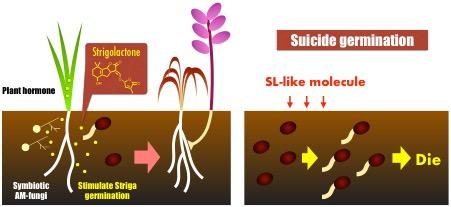Discovery of a hypersensitive suicide germination stimulant

Credit: ITbM, Nagoya University
An interdisciplinary team led by researchers at Nagoya University has discovered a highly potent and selective molecule, SPL7, that can lead seeds of the noxious parasitic weed Striga to suicide germination. Striga, also known as witchweed, has seriously affected millions of hectares of crop fields in Africa and poses a major threat to food security. Nevertheless, an effective method to control Striga infestation remains a challenge. In a new study reported in Science, ITbM’s chemists and biologists have come together to develop a promising molecule, SPL7, that selectively wither Striga at extremely low concentration. SPL7 is expected to alleviate Striga infestation and save crop losses worth of billions of U.S. dollars every year.
Nagoya, Japan – In various parts of sub-Saharan Africa, purple-pink flowers can be seen covering crop fields. While beautiful in sight, the plants with pink flowers parasitize through root system withdrawing minerals and water from crops and, thus, leading to the withering of the host before bearing grains. The plant, known as Striga hermonthica (Striga) or witchweed, is an African native parasitic plant which has co-evolved with sorghum as its natural host. Grown into 1 meter in height, Striga produces 50,000 tiny seeds throughout-crossing, thereby accumulating highly heterogenous seed stocks in the soil. In the past few decades, Striga has been expanding their geographic territories in vast African farmland over 25 countries and rapidly extending its host range to major crops including maize, millet, upland rice, and an Ethiopian crop called tef as the most recent victim. In severely infested areas, the number of Striga seeds reaches up to 15,000 per square meter, enough to completely eliminate crop productions from land that potentially produces 5 tons of maize per hectare. In such cases, smallholder farmers are forced to abandon their farm. The Striga endemic in sub-Saharan Africa has been emphasized by the United Nations as a major threat to poverty alleviation, as it economically impacts 10 billion US dollars per year and affects 100 million people. An interdisciplinary team led by researchers from the Institute of Transformative Bio-Molecules (ITbM) at Nagoya University has developed a promising molecule to combat against Striga.
Unlike common plants, seeds of Striga stay dormant in the soil over 20 years. The seeds germinate only after they sense a collection of small molecule hormones, strigolactones (SLs), that exude from the host. After germination, the seeds must parasitize the hosts immediately. Otherwise, germinated seeds will use up nutrients stored in the tiny seeds and wither within 4 days. This attribute has prompted researchers to develop SL-like molecules as inducers of suicidal germination to purge the soil of viable Striga seeds before planting the crop seed. However, this approach requires the development of potent and accessible compounds that only act on Striga and do not impede normal crop development. For example, SLs are also chemical cues that attract root symbiotic arbuscular mycorrhizal fungi (AM fungi) that supply host plants with nutrients. Despite the effort in developing over 300 SL-like molecules in the past 50 years, none of them possess both high potency and Striga-selectivity.
The molecular structure of SL is composed of an ABC-ring linked with a D-ring. Upon entering into the pocket of the SL receptor protein, SL is decomposed at the linker site. It has been thought that the structure of the D-ring is important, as it stays in the pocket to activate the receptor and lead Striga seeds to germinate. On the other hand, modifying the ABC-portion has been leading the development of variable SL-like molecules. Nonetheless, the exact structure providing Striga-selectivity was still unknown. The plant biology team at ITbM led by Yuichiro Tsuchiya initiated the search for a Striga-selective molecule from 12,000 synthetic molecules with random structures, and was able to identify a series of hit compounds (represented by a molecule called SAM690) that bind to an SL receptor in Striga, but not to that in the model plant Arabidopsis, and stimulate Striga seed germination with moderate activity (micromolar-range; 10-6 M).
The research went on with a serendipitous discovery of a highly active byproduct generated during the synthesis of hit molecules. The chemistry team led by Daisuke Uraguchi and Takashi Ooi isolated minuscule amount (0.01%) of the byproduct from a crude mixture of a SAM compound and identified its structure as a hybrid of SAM690 and the D-ring component of SLs. The optimized molecule, which is called sphynolactone-7 (SPL7), stimulated Striga germination at femtomolar (10-15 M) range, yet only bound to the SL receptor in Striga. The potency is on par with natural strigolactone, 5-deoxystriogl (5DS), which is the strongest germination stimulant to Striga among all commercially available compounds. Named after sphinx (a mystical creature with the head of a lion and the body of a human), SPL7 appeared as a hybrid molecule which inherits Striga-selectivity from SAM690 and high potency from SLs.
As expected from the selective binding to the SL receptor in Striga, SPL7 did not show typical SL activity in Arabidopsis, such as reduction of the number of shoot branches or elongation of root hairs. Not only to Arabidopsis, but SPL7 also appeared to have a limited effect on the growth of AM-fungi, which is an agronomically important microbe. Finally, the research team confirmed that SPL7 did induce suicide germination of Striga and protected maize plant from Striga parasitism in laboratory experiments. In conclusion, the team has proven that SPL7 is an effective Striga-selective suicide germination stimulant at least in laboratory experiments.
ITbM’s research team is planning to extend the discovery to field trials of SPL7 in Kenya.
###
Media Contact
Dr. Yuichiro Tsuchiya
[email protected]
Original Source
http://www.
Related Journal Article
http://dx.




